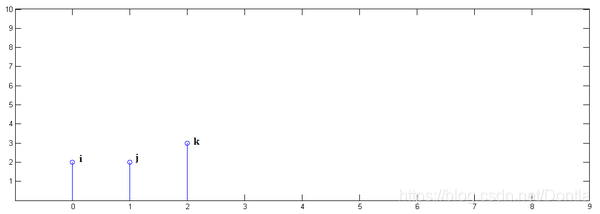from numpy.core.numeric()
def convolve(a, v, mode='full'):
"""
Returns the discrete, linear convolution of two one-dimensional sequences.
返回两个一维序列的离散线性卷积。
The convolution operator is often seen in signal processing, where it
models the effect of a linear time-invariant system on a signal [1]_. In
probability theory, the sum of two independent random variables is
distributed according to the convolution of their individual
distributions.
卷积算子经常出现在信号处理中,它在信号[1] _上模拟线性时不变系统的效果。
在概率论中,两个独立随机变量之和是根据它们各自分布的卷积分布的。
If `v` is longer than `a`, the arrays are swapped before computation.
如果“ v”长于“ a”,则在计算之前交换数组。
Parameters
----------
a : (N,) array_like
First one-dimensional input array.
第一个一维输入数组。
v : (M,) array_like
Second one-dimensional input array.
第二个一维输入数组。
mode : {'full', 'valid', 'same'}, optional
'full':
By default, mode is 'full'. This returns the convolution
at each point of overlap, with an output shape of (N+M-1,). At
the end-points of the convolution, the signals do not overlap
completely, and boundary effects may be seen.
默认情况下,模式为“完整”。
这将在每个重叠点返回卷积,输出形状为(N + M-1,)。
在卷积的端点,信号没有完全重叠,并且可以看到边界效应。
'same':
Mode 'same' returns output of length ``max(M, N)``. Boundary
effects are still visible.
模式'same'返回长度为``max(M,N)``的输出。 边界效果仍然可见。
'valid':
Mode 'valid' returns output of length
``max(M, N) - min(M, N) + 1``. The convolution product is only given
for points where the signals overlap completely. Values outside
the signal boundary have no effect.
模式'valid'返回长度为``max(M,N)-min(M,N)+ 1''的输出。
卷积仅针对信号完全重叠的点给出。 信号边界之外的值无效。
Returns
-------
out : ndarray
Discrete, linear convolution of `a` and `v`.
a和v的离散线性卷积。
See Also
--------
scipy.signal.fftconvolve : Convolve two arrays using the Fast Fourier
Transform.
scipy.signal.fftconvolve:使用快速傅立叶变换对两个数组进行卷积。
scipy.linalg.toeplitz : Used to construct the convolution operator.
scipy.linalg.toeplitz:用于构造卷积运算符。
polymul : Polynomial multiplication. Same output as convolve, but also
accepts poly1d objects as input.
polymul:多项式乘法。 与卷积相同的输出,但也接受poly1d对象作为输入。
Notes
-----
The discrete convolution operation is defined as
.. math:: (a * v)[n] = \\sum_{m = -\\infty}^{\\infty} a[m] v[n - m]
It can be shown that a convolution :math:`x(t) * y(t)` in time/space
is equivalent to the multiplication :math:`X(f) Y(f)` in the Fourier
domain, after appropriate padding (padding is necessary to prevent
circular convolution). Since multiplication is more efficient (faster)
than convolution, the function `scipy.signal.fftconvolve` exploits the
FFT to calculate the convolution of large data-sets.
离散卷积运算定义为
.. math ::(a * v)[n] = \\ sum_ {m =-\\ infty} ^ {\\ infty} a [m] v [n-m]
可以证明,在适当的情况下,时间/空间中的卷积:x(t)* y(t)等价于傅立叶域中的乘积:math:`X(f)Y(f)`。
填充(必须填充以防止圆形卷积)。
由于乘法比卷积更有效(更快),因此函数“ scipy.signal.fftconvolve”利用FFT来计算大数据集的卷积。
References
----------
.. [1] Wikipedia, "Convolution", http://en.wikipedia.org/wiki/Convolution.
Examples
--------
Note how the convolution operator flips the second array
before "sliding" the two across one another:
请注意,卷积运算符如何翻转第二个数组,然后才将它们“滑动”在一起:
>>> np.convolve([1, 2, 3], [0, 1, 0.5])
array([ 0. , 1. , 2.5, 4. , 1.5])
Only return the middle values of the convolution.
Contains boundary effects, where zeros are taken
into account:
>>> np.convolve([1,2,3],[0,1,0.5], 'same')
array([ 1. , 2.5, 4. ])
The two arrays are of the same length, so there
is only one position where they completely overlap:
>>> np.convolve([1,2,3],[0,1,0.5], 'valid')
array([ 2.5])
"""
a, v = array(a, copy=False, ndmin=1), array(v, copy=False, ndmin=1)
if (len(v) > len(a)):
a, v = v, a
if len(a) == 0:
raise ValueError('a cannot be empty')
if len(v) == 0:
raise ValueError('v cannot be empty')
mode = _mode_from_name(mode)
return multiarray.correlate(a, v[::-1], mode)
咋算的,我一点都没看懂??
计算流程
示例:
数字输入的是离散信号,如下图。
已知x[0] = a,x[1]=b,x[2]=c

已知y[0]=i,y[1]=j,y[2]=k

下面演示x[n]*y[n]过程
第一步,x[n]乘以y[0]并平移到位置0:

第二步,x[n]乘以y[1]并平移到位置1:

第三步,x[n]乘以y[2]并平移到位置2:

最后,把上面三个图叠加,就得到了x[n] * y[n]:

